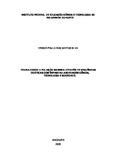Trabalhando a poluição marinha através de sequências didáticas com ênfase na abordagem ciência, tecnologia e sociedade

Visualizar/
Data
2023-02-01Autor
Silva, Erison Paulo dos Santos
http://lattes.cnpq.br/1070118245256796
Metadado
Mostrar registro completoResumo
The didactic potential that a Didactic Sequence (DS) presents is unspeakable for
a teacher, as it can enable the change of their posture in the classroom, because from it, the student assumes total autonomy regarding the various methodologies that are presented. A subject little explored in science teaching through methodologies that require greater student participation is marine pollution by sewage and household waste. In this work, we elaborate SD for the teaching of
the subject under the Science, Technology and Society approach, which allows even more autonomy on the part of the students, as they can become critical citizens before society with attitudes that promote knowledge of the human impacts on these environments and help them act responsibly. Once elaborated, the didactic sequences were validated by elementary school II teachers, since
they were proposed for this level of education. The validation mechanism was based on an electronic form that presented statements and questions about the sequences, seeking information about its didactic potential and its applicability in the classroom. Results indicated that the sequences are applicable in the classroom. The teachers considered that it is a great proposal to address this issue, as students become critical of the society in which they live, and it is a facilitating way to improve teaching-learning, for the simple fact that they have an excellent didactic potential through the teachers' validation, and emphasized that they are applicable in the classroom.



